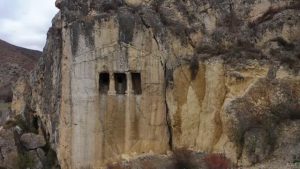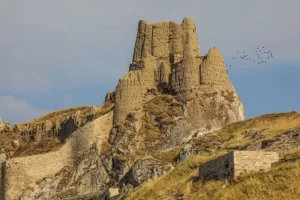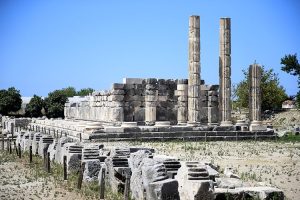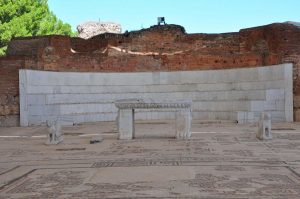
An amphitheater-like Neolithic structure has been uncovered at Karahantepe in southeastern Türkiye
Archaeologists in southeastern Türkiye have brought to light a striking Neolithic structure at Karahantepe—a circular, amphitheater-like building carved into bedrock and lined with tiered stone benches, human sculptures, and sculpted heads emerging from its walls. The find opens an unexpected window onto how some of the world’s earliest settled communities gathered, communicated, and expressed shared identity more than 11,000 years ago.
The discovery comes from large-scale excavations carried out under the Ministry of Culture and Tourism’s “Legacy to the Future” initiative, which supports work across Şanlıurfa’s Tek Tek Mountains. Karahantepe and the nearby Göbeklitepe form the core of the Taş Tepeler Project—a long-term scientific effort focused on understanding the rise of permanent life between 9400 and 8000 BCE.
A Monumental Gathering Space That Reshapes the Early Neolithic Picture
Excavation director Prof. Dr. Necmi Karul notes that Karahantepe was continuously inhabited for roughly 1,400 years. During that time, settlement architecture shifted from circular rooms to rounded-corner rectangular buildings, and eventually to fully rectangular structures—a sequence that mirrors broader social changes as mobile groups adapted to increasingly complex, sedentary life.

What sets this new structure apart is its unmistakably communal character. Archaeologists have now exposed the entire floor, hewn directly into the limestone, alongside multiple human heads carved into the walls and several seated human statues positioned around the interior. These features signal a profound departure from the animal-dominated symbolism long associated with Taş Tepeler sites—hinting at a moment when humans were becoming the central agents of ritual and social meaning.
📣 Our WhatsApp channel is now LIVE! Stay up-to-date with the latest news and updates, just click here to follow us on WhatsApp and never miss a thing!!
At the heart of the building lie three broad, curving stone benches, rising in tiers around a focal point where a prominent sculpture stands. The layout is unlike anything previously uncovered from the Early Neolithic Near East. While not a classical amphitheater in the architectural sense, its resemblance is impossible to ignore, suggesting intentional design for group viewing, listening, or collective participation.
More Than Ritual—A Social Engine Built in Stone
Although monumental Neolithic structures are often labeled “temples,” archaeologists today are increasingly cautious about applying later religious concepts to early Holocene communities. According to Karul, the architecture at Karahantepe likely served as a social integrator—a place where cooperation, storytelling, performance, decision-making, or other shared practices helped maintain cohesion among growing, more settled populations.
This perspective reframes the entire site: monumental architecture was not only a vehicle for belief, but also a tool for living together. The building’s complexity, symbolic program, and construction effort reflect the social pressures of a transformative era when humanity first experimented with permanent community life.

A Site That Rivaled—and Differed From—Göbeklitepe
Karahantepe shares certain visual hallmarks with Göbeklitepe, including T-shaped pillars and intricate carvings. Yet several elements remain unique. The site preserves one of the largest concentrations of human face depictions known from the Neolithic period, and its bedrock-cut rooms, corridors, and interconnected chambers point to a highly coordinated society capable of sophisticated architectural planning.
These characteristics position Karahantepe as a cornerstone of twenty-first-century archaeological research—one that is fundamentally rewriting expectations of early symbolic expression and communal architecture.
Reconstructing One of the Earliest Gathering Spaces in History
Restoration efforts continue, and several pillars are being re-erected as researchers prepare long-term conservation works. As this amphitheater-like structure comes into clearer focus, it underscores a profound message: long before metal, writing, or urban life, humans were already designing spaces that brought people together.
Far from a silent ruin, Karahantepe reveals an ancient landscape filled with voices, gatherings, and shared experience—an early blueprint for community carved into the bedrock of southeastern Türkiye.
Cover Image Credit: Eşber Ayaydın/AA
You may also like
- A 1700-year-old statue of Pan unearthed during the excavations at Polyeuktos in İstanbul
- The granary was found in the ancient city of Sebaste, founded by the first Roman emperor Augustus
- Donalar Kale Kapı Rock Tomb or Donalar Rock Tomb
- Theater emerges as works continue in ancient city of Perinthos
- Urartian King Argishti’s bronze shield revealed the name of an unknown country
- The religious center of Lycia, the ancient city of Letoon
- Who were the Luwians?
- A new study brings a fresh perspective on the Anatolian origin of the Indo-European languages
- Perhaps the oldest thermal treatment center in the world, which has been in continuous use for 2000 years -Basilica Therma Roman Bath or King’s Daughter-
- The largest synagogue of the ancient world, located in the ancient city of Sardis, is being restored











Leave a Reply